When it comes to setting up the right fishing rig there are often a few different factors that will determine your set-up. Location, target fish, size of the bait and the substrate we’re fishing in.
Even when we consider all these conditions there are three fishing rigs we can all start from. I often use these rigs in almost every situation or a modified version of these fishing rigs.
Paternoster Rig
A simple rig which helps present the bait just above the bottom of the seabed. I often use this type of rig for saltwater fishing including beach fishing, Estuaries, rock walls to even off piers.
A simple rig to tie as shown below. The mainline will get attached to a three-way swivel at the top with either a locked half-blood or clinch knot. The middle swivel end will be your dropper line approximately 15 to 20 cm and this will present your bait. The hook will be governed by the type of bait you’re using or the type of fish you’re trying to catch. This can all be tied up with a locked half-blood or clinch knot.
Finally, from the bottom of the three-way swivel, we’ll have our trace line approximately 50 cm to 1 m. At the end of the trace, we can either attach a bomb or star sinker with a locked half-blood or clinch knot.

Modified Paternoster Rig
A modified version of the paternoster rig that I also use is to attach two three-way swivels and present two hooks. This is great as it allows me to present two different baits or even two different types of hooks and test the waters for what’s biting.
Exactly similar process as above, except we’ll have approximately 30 to 40 cm of trace line in between the two three-way swivels.
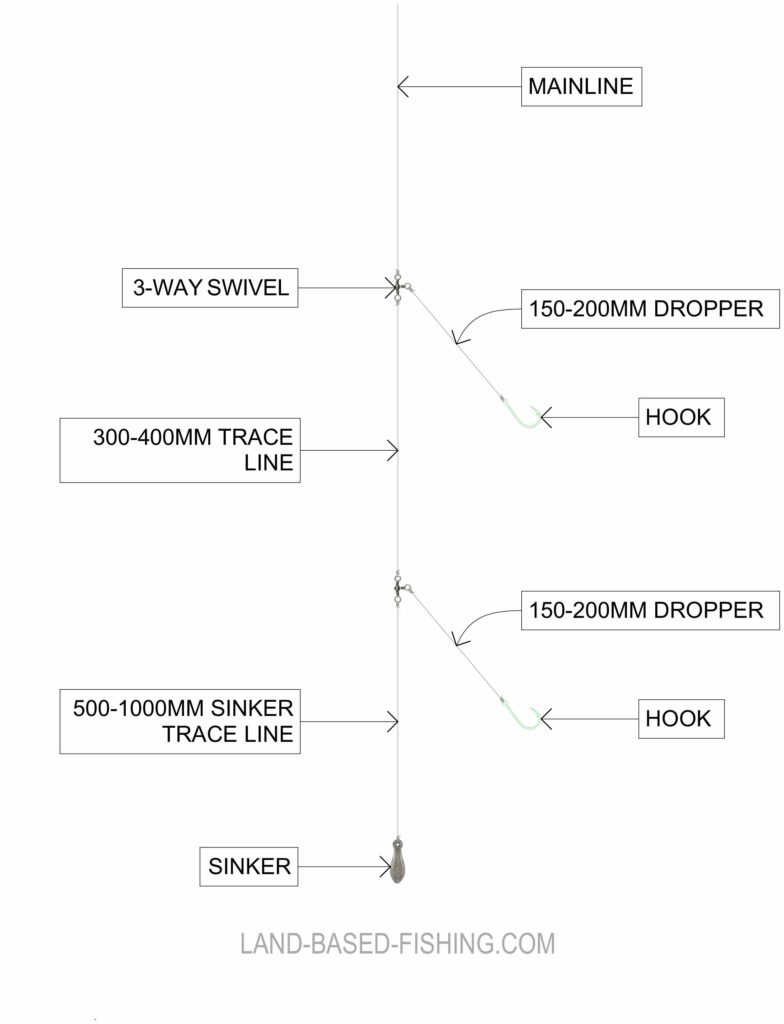
Running Sinker Rig
A very common rig used by many amateur anglers to even your experienced anglers is the running sinker rig. This type of rig works well for both saltwater and freshwater fishing.
A ball or bean sinker will be threaded through your main line before being attached to a single swivel with a locked half-blood or clinch knot. Following we’ll have our trace line approximately 40 to 50 cm attached to our hook. This will be governed by the type of bait or fish you will be targeting.
As the name suggests the sinker will be moving freely above your swivel and the key is to have the sinker as light as possible. Just enough to make a suitable cast.
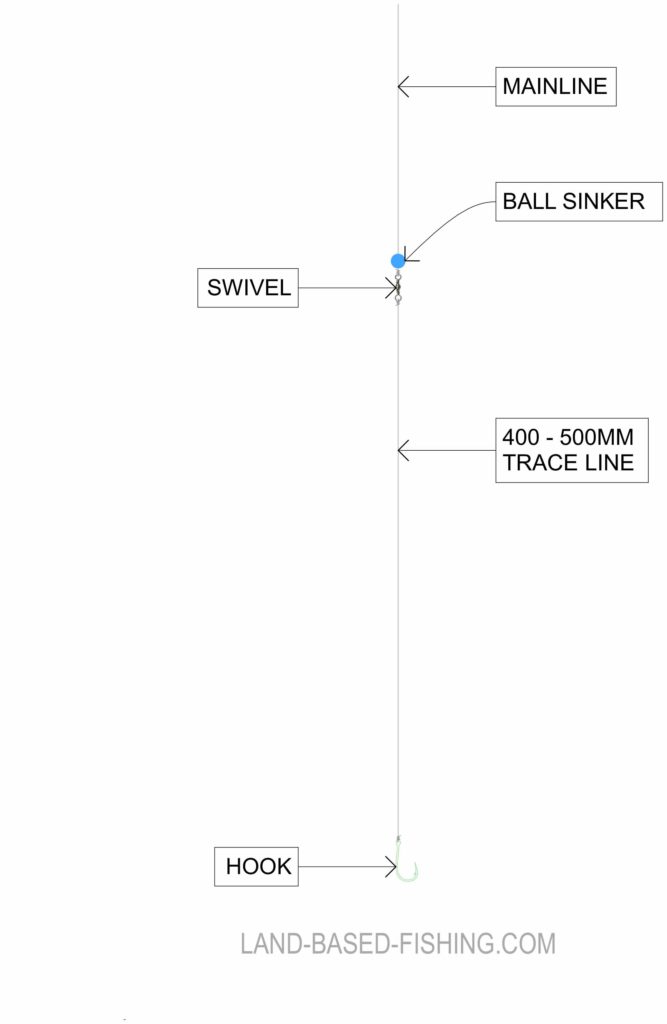
Modified Running Sinker Rig
A modified version of the running sinker rig I’ve used in the past is by having your ball sinker running the length of the trace line. This helps keep the weight as close to your hook as possible. Ideally, I would use this type of rig in estuaries and less snaggy bottoms.
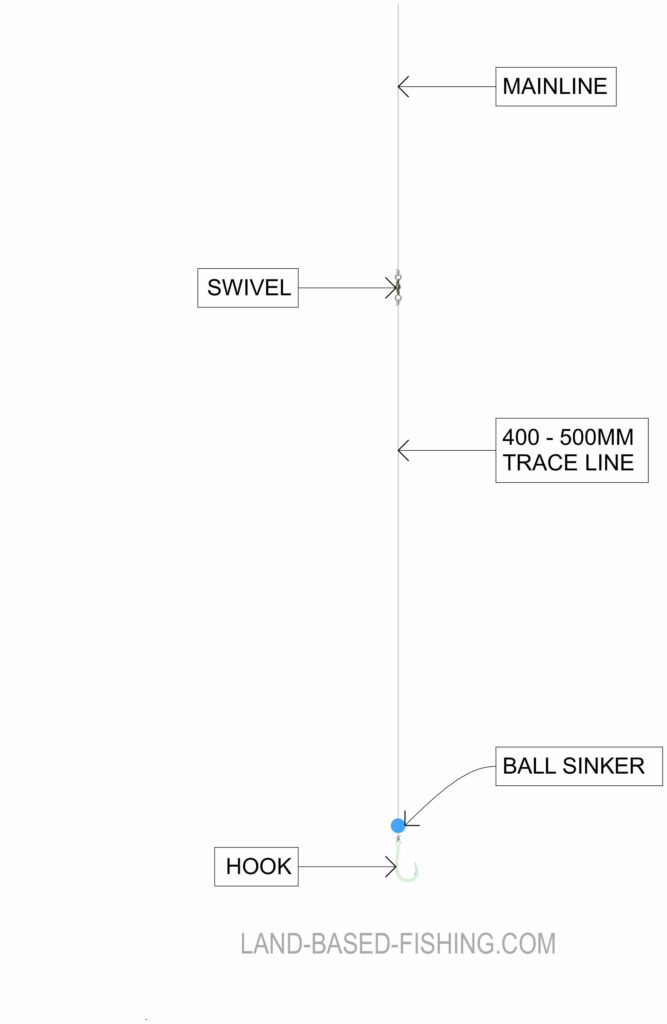
Float Rigs
When targeting fish within the top water column float rigs help present your bait within these zones. Ideally, when targeting garfish in marine environments or some freshwater species, float rigs are a must.
Float rigs can be set up with either a pencil, quill or bobber float by attaching the mainline through the top eyelet or clips. A 50 cm to even 2 meters of trace line will be attached to the bottom of the float. Following the end of your trace, we’ll have our hook attached with either locked half-blood or a clinch knot.
To help prevent the bait from floating to the top or strong currents taking it away. We’ll attach split shot sinkers approximately 15 to 20 cm above our hook.
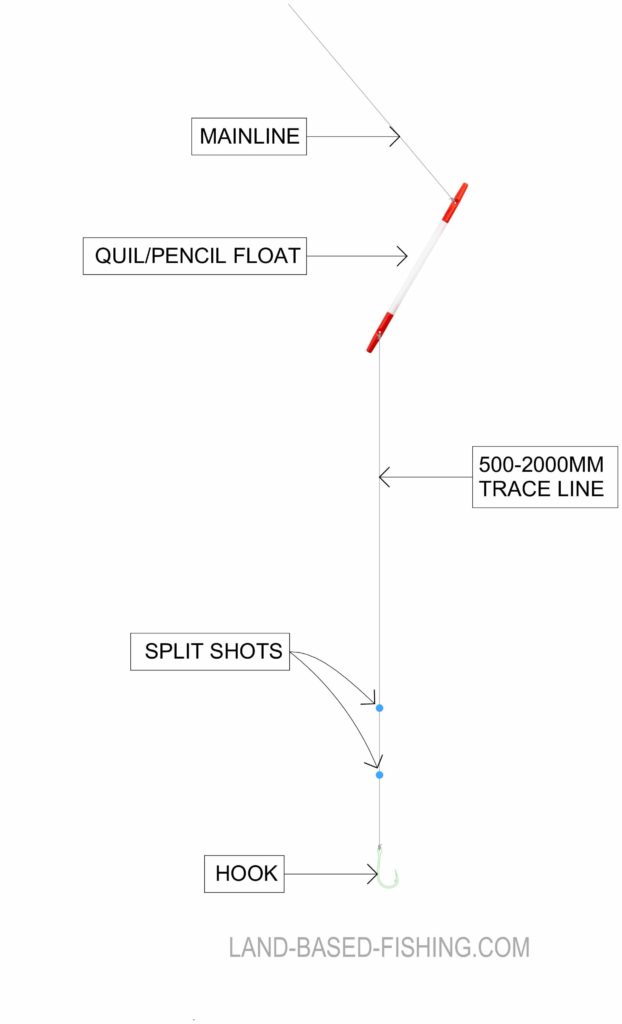
Modified Float Rigs
A variation of the float rig as seen below is by substituting our split shot sinkers with a ball sinker running freely along the trace line. A lightweight sinker will need to be used or you’ll find your float submerged.
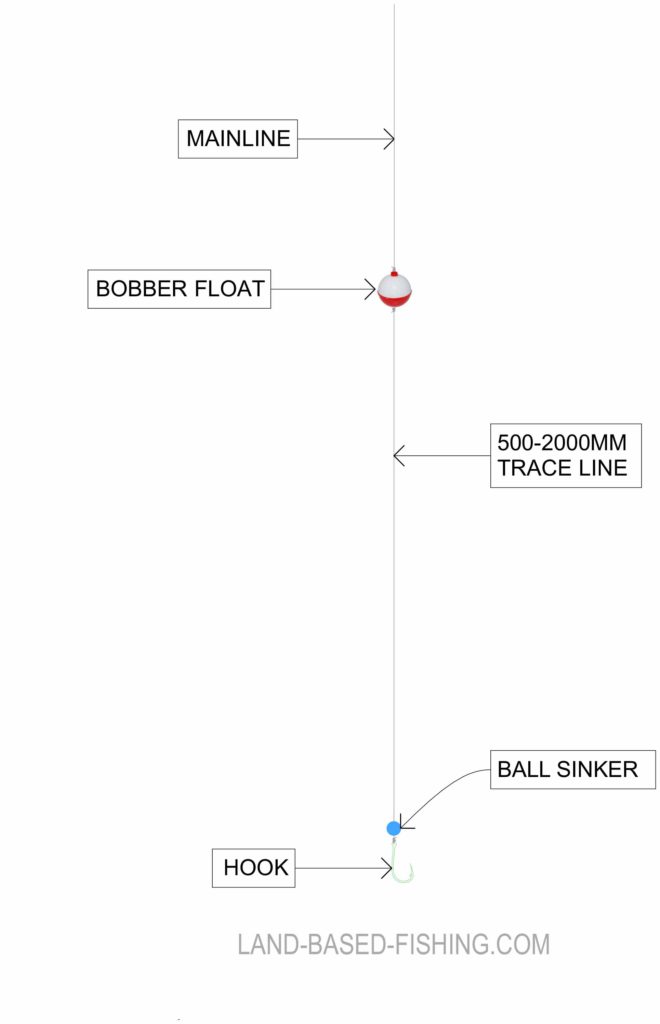

I have to be honest, I have never been much of a fisher but have always shown curiosity around it. Visiting your website really allowed me to visually test out the different types of fishing rigs while the schematics was a nice touch! I would say if I do fish for the very first time I would probably use the running sinker rig. Great site!
Hi Elviz,
Thanks for leaving a comment and I hope you do give fishing a go. Cause I know you’ll end up enjoying it 🙂
Cheers,
Vinnie
Hey Vinnie, nice to see you talking about fishing and rigs in general. It brings back a nostalgic feeling of how I used to go fishing with my dad back in the day. I learnt from your blog post that some rigs are meant for fresh water while some go better for salt water fishing. If ever I decide to go fishing again I’ll be sure to check back. It’ll share this with some of my friends who might be interested too. Best regards
Hi Henderson,
Thanks for dropping a comment and love for you to share this post around
Cheers,
Vinnie
Thanks a lot for the insightful and helpful article.
I love fishing. Unfortunately, in the part of the world where I live there is huge water scarcity. We have one river and in the last 37 years just twice I could see water in that river (All the ponds, lake, and well are dry). By GODS grace there are good signs that we might receive water soon because of some integration of rivers.
Although I love fishing because of the above problem not able to do it. I hope things going to change and I got great insights from your article.
Running Sinker Rig is the one I am interested with. To be honest, I don’t have much knowledge of fishing, this article is so thorough it opened my eyes to all sorts of information I wasn’t aware of!
Much Success!
Paul
Hi Paul,
That’s really unfortunate to hear and i guess where I’m from I take the rivers, oceans and lakes for granted. But definitely do make the most of fishing these areas. I hope one day you can go fishing and really enjoy this sport. As always thanks for leaving a comment. Really appreciate it 🙂
Vinnie
gday vinnie,
My dad taught me how to fish many moons ago now but as I read more and more I realise just how many different ways there are to throw a line in the water.
I have got a few questions I am hoping you can answer.
First up, what is the first rig I should be teaching my son (preferably something easy and safe)? He likes to catch the hook into his hand.
Second, can the hooks from all these rigs be interchanged with lures?
Lastly, how feasible is it to make these rigs at home then take them to the beach and tie them on when needed?
Hi Remy,
Firstly, thank you for leaving a comment and taking the time to read my post 🙂
For beginners to start from I would recommend using a running sinker rig. It’s the easiest rig to set-up and also quite effective. Not only that, this rig is easy to handle and while not in use can be hooked to your rod guides. This prevents any loose hooks swinging around and accidents occurring.
As for lures being interchanged onto these rigs. I won’t recommend it as the best way to tie lures is directly to the lure or jig head itself. This allows the lure to perform its action underwater to its full capability.
To answer your last question, Absoutly feasible! I prepare all my rigs at home before heading out onto the water. As this prevents any time wasted and only requires me to tie my rig straight onto the leader line and start fishing.
Excellent and educative article,visiting your website truly enabled me to outwardly test out the various sorts of angling rigs while the schematics was a pleasant touch! I have never been a lot of a fisher yet have consistently indicated interest around it. I would state in the event that I do angle for the absolute first time I would likely utilize the running sinker rig.You are helping a lot of people with this wonderful write-up.Thank you for sharing.
Hi Abayomi, Thanks for taking out the time from your blog and leaving a comment. Also, Always appreciate the positive feedback!
All the best,
Vinnie
Thank you Vinnie, for sharing the different types of rigs. I will experiment with various types. Which rig is best in fresh water that prevents under water snags? I find that most amateur fisherman use to big of hook. I am going to return to your website frequently to learn more fishing techniques.
Hi Tom,
Thanks for leaving a comment. As for the best rig for freshwater, This will entirely depend on the fish you’re targeting. But to start with I would recommend using a running sinker rig and hook depended on the bait you’re using. As for preventing snags, this rig will ideally work well in snaggy bottoms but sometimes its just bound to get snagged even if your being really careful. All the best mate and happy fishing!
Float Rigs here above;
https://land-based-fishing.com/different-types-of-fishing-rigs/
Can you advice what is the optimal distance recommended from Split Shot/s (one or a bulk) on a Sliding Slip Float rig for Saltwater fishing?
Best regards,
Sam
PS; kindly drop your wisdom also to my email.
Hi Sam,
Thank you for leaving a comment. Generally, I keep my split shots approximately 150-200mm apart and about 400-500mm from my hook.
As long as the split shots are keeping the bait suspended within the middle to the topwater column. Hope this helps!
Cheers,
Vinnie
I do apologize but I fail to understand-see the printed paragraph right above the Quil/Pencil Float Rig image-Quote; “To help prevent the bait from floating to the top or strong currents taking it away. We’ll attach split shot sinkers approximately 15 to 20 cm above our hook.”
The image refers as it looks to a Fixed Float, is it the same 15 to 20 cm above our hook also on a Slip Float Rig, or the split shots are pinched above the 400 to 500 mm trace you mention in your reply and spaced above the the trace length?
Hi Sam,
It should be the same, the only real difference in a slip float is that you’ll have a stop knot above your float.
Sorry, i might have confused you. How far you fix your split shots will depend on how long your trace line is.
For example if I would to have a 1 meter trace line then i’d fix my split shots 150 – 200mm above the hook.
For longer trace lines say 1.5 – 2 meters in length then 400 – 500mm would be a good starting point.
All clear as crystal Mr. Prasad, thank you for your time and consideration.
All the very best,
Sam
Not a problem Sam! I’m glad i could help.
Cheers,
Vinnie
Looking at the modified Float Rig above; the ball sinker holds the line vertically tight and will move pendulum like in currents.
As the line end has no flexibility like a classic Float Rig on its end, will this not scare-off fish from biting?
What is the logic and experience on such a rig?
Regards,
Sam
Hi Sam,
I often use this rig setup on Garfish and they haven’t been spooked away.
I generally use a fluorocarbon leader as the trace line to help with visibility of the line. Also, keep my tackle as light as possible that I can get away with.
To be honest, you’ll just have to get out there and try for yourself and see what results you achieve.
This is excellent!
Quick one: when running a two-hook paternoster, do the three way swivels lead to tangles? ie would tying a loop mean the hook length stands proud of the knot and less likely to tangle?
Cheers
Ian
Hi there,
Can you kindly elaborate the logic and ‘operation’ of the Modified Running Modified Rig’,; having your ball sinker running the length of the trace line, and why its use is a less snaggy bottom.
Regards,
Sam
Hi Vinnie;
Please, can you elaborate the Modified Running Rig pros & cons; I have noticed the rig is not mentioned anywhere on the list of fish types tips and advice what rig recommended rig.
Regards
Sam